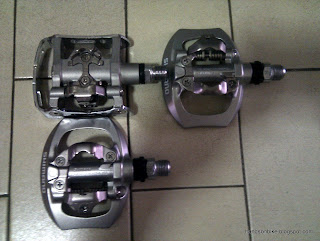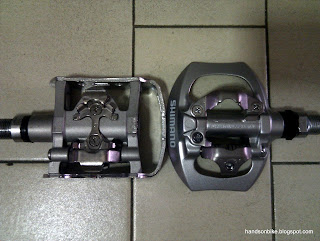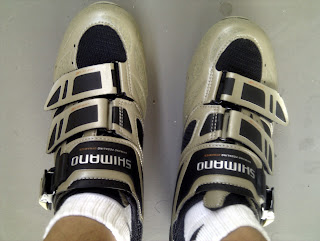It has been a while since I blogged about my Dahon Boardwalk X20-R! For this couple of months, I have been mostly writing about the new Flamingo folding bike. But that didn't mean that I have not been riding my Dahon. In fact, I have been testing a new upgrade on my Dahon Boardwalk for the past 2 months. The reason it took so long is because it is very new to me, and also because it takes more than just a few rides to evaluate this product. Some eagle-eyed people may have already noticed my new component during these 2 months.
As you would have seen from the blog title, this new product is clipless pedals! The whole set of Shimano SPD includes the SPD shoes, the pedals, and the cleats that link the shoes to the pedals. There are a few differences between SPD for road shoes/pedals and SPD for MTB shoes/pedals. See the picture below for the differences.
Differences between Shimano Road and MTB cleats and pedals
Shimano R240 Road Cycling Shoes. Note the triangular 3 point mount on the sole.
A road cycling shoe with the triangular cleats mounted. The larger cleat size supposedly makes it more comfortable for pedaling as it spreads the pedaling force over a larger area on the sole.
Shimano M240 MTB cycling shoe. Although there are 4 holes on the sole, you only need to use 2 of them to mount the cleats. Cleat size is smaller. More pictures can be seen below.
Besides the physical differences in the cleats, cycling shoes and pedals, there are also different characteristics between these cycling shoes. The table below summarizes these differences very well!
A table comparing the differences between Road and MTB SPD systems.
For me, I chose to use MTB shoes as it allows me to walk properly when off the bike, as the cleats do not protrude from the bottom of the shoe unlike road cleats. Unless you are going for lightweight, the MTB shoes are more suitable for rides that involve some walking instead of pure riding. Nobody says that you have to use Road SPD pedals on a road bike! There are many instances where riders prefer MTB cleats and pedals on a road bike because of the advantage of being able to walk properly using MTB cycling shoes.
My Shimano MTB Cycling Shoes!
With these MTB shoes, I can walk almost normally when off the bike, because the cleat underneath the shoe is recessed and does not contact the ground (usually). The main strap also uses a useful click-tightening system that allows you to fine-adjust the tightness of the strap easily.
Of course, with MTB shoes I will need MTB cleats! For the Shimano SPD system, there are 2 main types of cleats, the normal SH51 single-release cleats and the SH56 multi-release cleats. Apparently the SH51 cleat can only be released by twisting the shoe outwards, while the SH56 cleats will release by twisting either way or even when you pull up hard enough!
As a first timer using cleats, I chose to play safe and use the multi-release cleats. According to reviews online, these cleats will also release when pulled hard enough, such as in an emergency when you suddenly need to release your foot from the pedals.
Multi-release SH56 SPD cleats
I have inspected both the SH51 and the SH56 cleats closely, but can't seem to find any difference. Probably just some small differences in the chamfers or shape of the cleats.
Slots both on the shoe and the cleats for fine-tuning of the cleat position
Cleats mounted on the carbon fiber sole. Also note how the cleat hides under the studs of the shoe, protecting it from damage due to contact with the ground.
The first time you try walking with a hard soled cycling shoe, it will feel very awkward, as the sole is totally rigid and does not bend with your foot, unlike normal shoes. This makes walking somewhat weird as it feels like walking in clogs. As you get used to it, you will be able to walk normally.
The point of using cleats and cycling shoes is to make your foot stick to the pedal when you cycle! MTB shoes are used with MTB pedals, since the cleat system has to be compatible. There are also other types of pedals that are neither pure MTB or Road pedals.
Although I want to try clipless pedals, I don't want to give up the convenience of having a platform (flat) pedals for casual rides. For example, during casual Sunday group rides, I would not want to use cycling shoes as it is more risky and troublesome if you need to clip in and out frequently. Also, I may also want to cycle in slippers when I go to a friend's house nearby or out to buy lunch.
There are a few types of Shimano pedals that can accept MTB cleats:
1) Pure MTB pedals. These pedals are usually very small and lightweight. The pedaling platform is created by the hard-soled shoe and not the pedal itself. The problem with these pedals is that without the proper cycling shoes, it is very difficult to pedal with other types of shoes. Even for those with an external cage, you will still feel a lump on your sole through your shoe, caused by the cleat mechanism on the pedal.
Shimano PD-M520. Only area on the pedal is the cleat mechanism! Impossible to cycle without using MTB cycling shoes.
Shimano PD-M530 pedals. New and alternate version of the M520 pedals. Comes with an external cage to increase the area available for pedaling when not clipped in.
2) Dual sided MTB pedals with large external cage. These are pedals targeted at more casual riders, who wish to have the convenience of having a dual sided clipless pedals and also a platform pedal. The cage is thicker and is easier to pedal even without MTB cycling shoes. However, the cleat mechanism does not retract fully into the pedal, and the mechanism can still be felt through your shoe.
Shimano PD-M545 pedals. Dual sided cleat mechanism and also platform pedal
3) SPD mechanism on one side, platform pedal on other side. This is the pedal that I am using, as I find it most suitable for my needs. When I want to clip in, I use the side with the cleat mechanism. For casual rides with non-SPD shoes, I just use the platform side. Although the pedal will be facing the wrong way half the time, with some practice, it is easy to flip the pedal over. I feel that it gives me the best of both worlds, without needing to compromise on comfort unlike the previous 2 types of pedals.
Shimano PD-M324 pedals. Flat on one side, cleat mechanism on the other.
Most clipless pedals these days come with adjustable spring tension on the pedals. For beginners, a low spring tension is recommended, for ease of clipping in and out.
The cleat position on the shoe is also very important. Putting the cleats too far forward or backward will make your pedaling feel strange as the pressure point will not be on the ball of your foot. Shifting the cleat from side to side also allows you to place the shoe more inward or outward on the pedal to compensate for each individual's pedaling technique.
Initially, learning to ride with clipless pedals can be daunting. As you start off, you can clip in easily, yet you worry if you can manage to clip out when you stop! Best way to learn is to cycle in a safe place, preferably with a kerb or wall for you to get some support if you need to.
Also, I had to relearn how to mount the bike and also dismount from the bike. Previously when I was not using clipless pedals, I dismounted with one foot on the ground followed quickly by the other foot. It did not matter which way I leaned as both feet would touch the ground and provide balance.
However, I quickly learnt that this method will not work for clipless pedals! It is important to ensure that you always land first on the foot which you have clipped out. For me, I will unclip my right foot before I stop, and as I dismount, I will lean a bit to the right so that as I come down and straddle the bike, my right foot touches the ground first. Then, I will quickly unclip my left foot and plant it on the ground also. It is not recommended to unclip both feet before stopping, as the bottom of the cycling shoes are hard and slippery, and you will slip off the pedals easily when not clipped in. I learnt that the painful way when I slipped off the pedals and cut my shin on the edge of the pedals.
As for moving off, I will always clip in my right foot and bring it up to the 3 o'clock position, when viewed from the right. To move off, I just push off with my right foot and sit on the saddle. I will then flip/clip in to the left pedal as I pedal off. It is good practice to clip in the starting foot before you move off. This will help you avoid fumbling with the pedals when the lights turn green.
If I am stopping beside a kerb, I will unclip my left foot and rest it on the kerb for support. The right foot will remain clipped in, ready to pedal and move off.
The cleat side of the pedal. These pedals were mounted before I had changed to the Ultegra crankset.
The other side of the pedal, with the wide platform suitable for pedaling with non-cycling shoes.
I did not write a review on these pedals and shoes earlier as I wanted to try it for an extended period to see if it is good. So far, I have done multiple Tuas night rides, the NTU Bike Rally and the OCBC Cycle 39km Challenge while clipped in on these pedals, and many more casual rides while using the platform side.
Using clipless pedals can help you generate more power, as it allows you to pull up as well as push down on the pedals. It also trains you to have a good pedaling technique as you can try to pedal in smooth circles instead of only pushing down on the pedals. When I try pedaling with only one foot, I realise how bad my pedaling motion is, as the pedal does not go in a smooth circle but jerks around.
Note that the benefit of additional power usually only happens when you pedal hard. Pedaling casually is unlikely to involve pulling up on the pedals, unless you consciously pull up on the pedals. There is a lot of potential for using different muscles (hamstring) on the legs for pedaling, but so far I have not maximised that potential.
So far, so good! I am pleased with these MTB SPD pedals and shoes. Also, I am lucky to have no accidents with these pedals. Although there have been a few close shaves where I have unclipped my right foot, only to lean to the left, I have always managed to pull my left foot out, thanks to the low spring tension on the pedals and the multi-release cleats that I am using. What I feel is that most of the time, people fall while clipped in not because they cannot get their foot out, it is because they FORGOT to unclip. The key to smooth and safe operation is practice!
If you are intending to give SPD pedals a try, hesitate no more! It is safe as long as you do not overestimate yourself, and take your time to practice clipping in and out. There are many benefits to using clipless pedals, although you will still get along fine without it.


























































